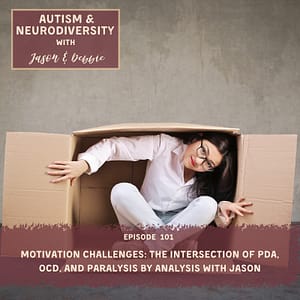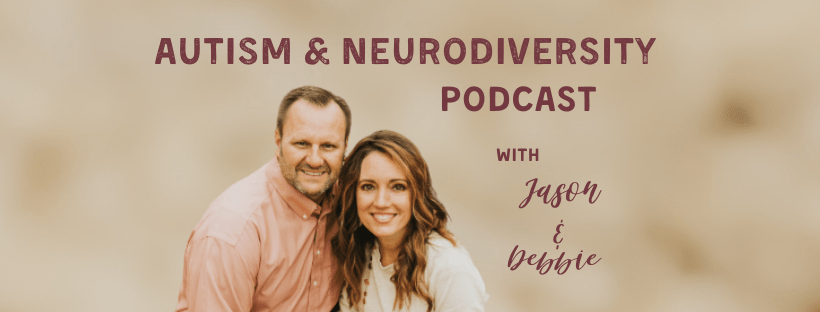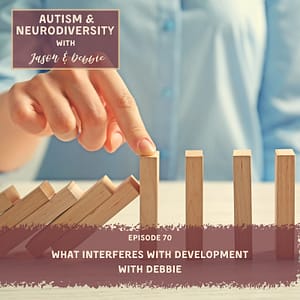[00:03] Jason: Welcome to the Autism and Neurodiversity podcast.
[00:06] Debbie: We’re here to bring you helpful information from leading experts and give you effective tools and support. I’m Jason Grygla, a licensed counselor and founder of Techie for Life, a specialized mentoring program for neurodiverse young adults.
[00:19] Jason: And I’m Debbie Grygla, a certified life coach. And maybe most importantly, we’re also parents to our own atypical Young Adults.
[00:30] Debbie:
Friends, hello. Good to have you here. So working with autistic and neurodevergent young people, it can be extra hard to know what’s helpful and what’s not. And at Techie for Life, our school and mentoring program for neurovergent young adults, over the last six plus years, we’ve learned a few things as we are actually putting things into practice, right?
We’ve learned what works and what doesn’t. And we’ve honed in on how to better support development and growth adulting. And unfortunately, Jason and I did it. And many of us with good intentions are actually sabotaging development and we don’t even realize it. And over time, that can be really discouraging. When you really are investing so much of your time and your energy and your emotions and your money, right?
When you’re a neurodivergent young person is still struggling and not making much progress, and things actually get harder as they get older, in some ways that gap of progress can start to become even more accentuated.
And so the biggest thing that we see that gets in the way of development is anything that contributes to them going or staying in a lower brain threat response survival state. No matter where someone is at in their development, this will always be true. And no matter a person’s neurotype.
Okay, this goes for neurotypical kids. But it’s especially important to understand when someone’s neurodivergent, because we don’t develop when we’re in lower brain states. And our neurodivergent young people, like the studies and brain scans and the things that are coming out from the neuroscience, is showing that neurodivergent brains have a harder time shifting out of a lower brain state. They don’t have as much ability in their prefrontal cortex to be able to manage their lower brain and pull themselves out of that state or to pause and slow down going into that state.
So it’s extra important to understand this when you’re working with virgin young people. We don’t develop when our lower brain is kicked into gear and in survival mode. We develop when we’re in a higher brain, emotionally regulated state, when we feel safe and we’re getting our basic needs in it.
So what does it look like when they’re in a lower brain state? What does that really look like? It can look like emotional meltdowns outwardly or setting down inwardly. It can look like hyper manic behavior or very lethargic and depressed.
So what’s actually happening is the sympathetic nervous system has two parts. The nervous system has two parts the sympathetic system, the sympathetic nervous system, and the parasympathetic nervous system. And the sympathetic nervous system is like hitting the gas pedal that is that fight response. And then the parasympathetic nervous system is the system that creates breaks that’s the flight and freeze responses. And then kind of the fawn is a little in the middle there.
So you’re getting like the gas pedal hyper / manic or the brake pedal lethargic and depressed and it’s all a threat response. And it’s not coming from the higher brain, it’s coming from the lower brain. We’re in danger, did something.
So that’s where you might get the gas pedal needy, really needy and grasping and demanding your attention nonstop or the brake pedal detached. The only thing to do with you don’t reach out, don’t connect, right? It can look like spinning, the gas pedal spinning, they’re spinning out and they’re going in circles, not going anywhere and they’re just still hitting the gas pedal in that spin or completely checked out. Nothing happening. They just can’t.
It can look stubborn and rigid or people pleasing with no backbone, okay? It can look like when they’re just overwhelmed, tons of energy going into overwhelm or just, blah, not carrying at all anymore.
It can look like overtly sabotaging their success or inwardly self sabotaging. It’s that fight aggressive proactive gas pedal or that brake pedal where it’s avoid, withdraw, flight or freeze like spin, get stuck.
Or the fawn where it’s kind of it can look a little passive aggressive or like people pleasing or when they have no sense of identity and they just look to everyone outside them for identity. This is also where you see the masking happening. If they’re masking and pretending to be something they’re not to fit in or to not get in trouble or to get rewarded, they’re masking. That is exhausting. It takes so much energy and it’s coming from a very lower brain sympathetic nervous system triggered response. It takes so much effort to put on that mask and it’s exhausting and it causes a lot of mental health issues later.
So that’s what that lower brain response can look like. And then as parents and mentors, there’s things that we do that can influence or trigger them. Either going into that lower brain threat response or staying and even getting more habitually entrenched in it where the brain just goes into that and that’s just what they know and so want you to be aware of that.
The thing that can keep them that we’re doing that we actually have influence in is our own lower brain state, okay? So how we act, how do we behave, how do we show up as parents and mentors when we’re in a lower brain threat response triggered state when we’re in the throws?
Like how does that look for you when you’re in the throws of stress and fear and anxiety and overwhelm and hyper vigilance or you’re feeling the other way? That’s like all the gas pedal stuff, right? Or like the brake pedal feeling avoidant or depressed or just giving up, like shutting down at your breaking point.
When we’re in that state, it’s impossible to show up as our best self and bring all of our talents and intuition and resources and problem solving skills and abilities. It’s impossible to access that when we’re in a stressed state. And often what it will look like is when we’re feeling all that, when we’re feeling that stress and we’re in that lower brain state, we can tend to get controlling and really micromanaging and bossing and angry and yelling and just really controlling or we get really avoidant.
We don’t want to deal with it. We ignore. We don’t address issues. We go to the extremes, right? We might overreact or we don’t respond. We don’t pick up on, and we’re not noticing when they’re getting stressed and when they’re about to maybe have a meltdown or we’re hitting that gas pedal like, oh, no danger gas pedal, and we overdo. We just continually overdo. Or the brake pedal. We underdo things, right?
And let me tell you, if you’re under doing, they’re getting overwhelmed. They’re probably getting overwhelmed. And if you’re overdoing, they’re going to underdo. They’re going to underperform. If you’re overdoing, they’re going to underperform. It’s kind of the nature of it.
So when we’re in that lower brain state and we’re stressed, we actually have a really hard time connecting. The brain is not thinking about connection. It’s thinking survival. What do we do to get out of this terrible state we’re in? Get out of danger, right? And when we’re in that survival mode, we can’t be there for young people when they’re in their survival mode, okay? When you’re stressed out, it’s really hard to give support, like empathy and connection and be able to collaborate, let’s work together and figure this out or to just comfort and nurture.
So I want you to be aware of that and then understand that development happens when we’re uncomfortable or in other words, when we’re challenged.
If we’re comfortable and it’s not a challenge, we’re not developing. We’ve already got the neuropathways. We already know how to do the thing. So development happens when we’re uncomfortable, when we’re being challenged a little bit, but the key is challenged but not overwhelmed, okay? We have to really watch when we get into either too much or too little extremes, okay? Then we’re getting in the way of development.
So if we’re offering too much comfort, we’re going to get in the way of their development. If we don’t offer enough comfort, that’s going to be a problem. We want to find that good enough middle space. Too much help can inhibit their development. Too little help will inhibit their development. Too much money. Too little money, right. Too much.
Too high of expectations and too low of expectations. If they’re too high, it’s like overwhelming, right? But if we have too low of expectations, there’s no challenge. It’s almost insulting, right?
If there’s too much responsibility that we’re giving them, it overwhelms them. If there’s not enough, then they don’t ever really learn and grow and develop. Another big one is too much stimulus or too little stimulus.
For some of our neurodivergent young people, they need a lot of stimulus to be able to be emotionally regulated. And then for others, too much stimulus just completely overwhelms them and they shut down.
It’s interesting, when I was in charge of the children at church, like the Children’s program, we would teach the kids in the classroom, the big classroom. And we had one of the moms just went all out, super talented and creative and artistic, and she just did the most amazing wall display and it had big bold colors and cut outs and shape. It was just the most amazing wall display. And I was like, oh my gosh, this is so amazing. I can’t believe this mom did this and put so much time and effort into it. And then unfortunately, the kids came in and a lot of the kids loved it, right? But then there was some of our kids that had ADHD or had autism that were ADHD or autistic. And I still remember this one little boy, he just wouldn’t even come in the room. We couldn’t figure out what was going on. And then finally we problem solved and finally figured out, oh my gosh, the wall was just so overstimulating.
It was actually hurting his brain. He was like, I have a headache. Like my brain hurts. Like his eyes were hurting. He could not handle the stimulation of that wall, right? So too much or too little?
Too much social. Too little social. Too much stuff or too little stuff?
Okay, so the stuff thing for neurodivergence, I would err on the side of less stuff. There’s been studies that just shows, especially ADHD years, if they have a ton of stuff, it just adds so much distraction to their brains. So simply just simplifying, living a more minimalist lifestyle, creating a more minimalist home environment can really make a big difference. Like deleting and ruthlessly removing clutter and simplifying the environment can make a huge difference.
Opportunities, too many opportunities, too many choices can be like pressure, right? But not enough opportunities. And there’s not that opportunity to grow and develop. So it’s looking for balance. It’s looking for that kind of good enough middle and working to meet their needs physically, emotionally, intellectually and socially, wherever that is for your young person that you’re working with and parenting, navigating a good enough amount of support is truly a nuanced start. It takes a lot of curiosity and compassion and intuition.
And when you’re in a lower brain stress state, you’re just so much more less likely to have the mental emotional wherewithal to be able to navigate things successfully. So the work that we have is to not beat ourselves up over our stress state. That just adds more stress. Super Not Helpful.
It’s to recognize that supporting ourselves when we’re in a lower brain state is going to help us be the mentor that we want to be. Okay? That is the thing that will help us move into a higher brain state. It’s not fixing all the problems. It’s not coming up with the perfect solution and the perfect therapy. Or the perfect treatment. It’s actually recognizing when we’re in a lower brain state and then supporting ourselves in ways taking care of ourselves in ways that we can move into a higher brain state more easily. Okay?
And that’s the work I do with so many parents is helping them gain awareness of the things that keep them in lower brain states and then being able to that practice of processing emotions and be able to move into higher brain states and then the details and figuring out where that good enough space is. It just gets so much easier when we’re in that confident, secure. We got this. We can figure this out. State. Even when you have a kid having a meltdown, like when we practice recognizing our own state, then we can respond to meltdowns in a completely different way and hopefully not meltdown as much. Right?
Like it’s just a practice. And then when we have those meltdowns ourselves, we can comfort ourselves and take care of ourselves so that we can be able to move back into a higher brain state when we’re ready.
So I hope this is helpful. I hope you’re taking care of yourself and actually prioritizing that. And don’t ever believe a lie that you can’t take care of yourself or you don’t have enough time because you have a disabled child or a child. That’s really Hard. It Is Actually Critical. You will have more energy and more emotional capacity if you take care of yourself first and move into that higher brain and do the practice, do the work of moving into a higher brain state. So have an amazing week and take care of yourself.
[13:07] Debbie: Thanks for joining us on this episode of Autism and Neurodiversity with Jason and Debbie. If you want to learn more about our work, come visit us at jasondebbie.com.




